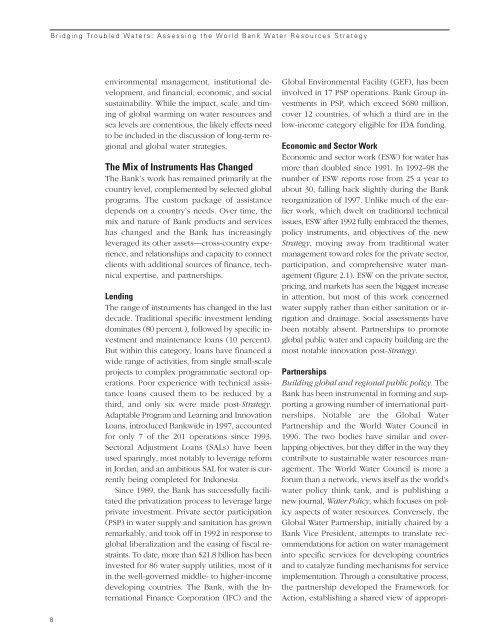Download Report - Independent Evaluation Group - World Bank
Download Report - Independent Evaluation Group - World Bank
Download Report - Independent Evaluation Group - World Bank
You also want an ePaper? Increase the reach of your titles
YUMPU automatically turns print PDFs into web optimized ePapers that Google loves.
Bridging Troubled Waters: Assessing the <strong>World</strong> <strong>Bank</strong> Water Resources Strategyenvironmental management, institutional development,and financial, economic, and socialsustainability. While the impact, scale, and timingof global warming on water resources andsea levels are contentious, the likely effects needto be included in the discussion of long-term regionaland global water strategies.The Mix of Instruments Has ChangedThe <strong>Bank</strong>’s work has remained primarily at thecountry level, complemented by selected globalprograms. The custom package of assistancedepends on a country’s needs. Over time, themix and nature of <strong>Bank</strong> products and serviceshas changed and the <strong>Bank</strong> has increasinglyleveraged its other assets—cross-country experience,and relationships and capacity to connectclients with additional sources of finance, technicalexpertise, and partnerships.LendingThe range of instruments has changed in the lastdecade. Traditional specific investment lendingdominates (80 percent ), followed by specific investmentand maintenance loans (10 percent).But within this category, loans have financed awide range of activities, from single small-scaleprojects to complex programmatic sectoral operations.Poor experience with technical assistanceloans caused them to be reduced by athird, and only six were made post-Strategy.Adaptable Program and Learning and InnovationLoans, introduced <strong>Bank</strong>wide in 1997, accountedfor only 7 of the 201 operations since 1993.Sectoral Adjustment Loans (SALs) have beenused sparingly, most notably to leverage reformin Jordan, and an ambitious SAL for water is currentlybeing completed for Indonesia.Since 1989, the <strong>Bank</strong> has successfully facilitatedthe privatization process to leverage largeprivate investment. Private sector participation(PSP) in water supply and sanitation has grownremarkably, and took off in 1992 in response toglobal liberalization and the easing of fiscal restraints.To date, more than $21.8 billion has beeninvested for 86 water supply utilities, most of itin the well-governed middle- to higher-incomedeveloping countries. The <strong>Bank</strong>, with the InternationalFinance Corporation (IFC) and theGlobal Environmental Facility (GEF), has beeninvolved in 17 PSP operations. <strong>Bank</strong> <strong>Group</strong> investmentsin PSP, which exceed $680 million,cover 12 countries, of which a third are in thelow-income category eligible for IDA funding.Economic and Sector WorkEconomic and sector work (ESW) for water hasmore than doubled since 1991. In 1992–98 thenumber of ESW reports rose from 25 a year toabout 30, falling back slightly during the <strong>Bank</strong>reorganization of 1997. Unlike much of the earlierwork, which dwelt on traditional technicalissues, ESW after 1992 fully embraced the themes,policy instruments, and objectives of the newStrategy, moving away from traditional watermanagement toward roles for the private sector,participation, and comprehensive water management(figure 2.1). ESW on the private sector,pricing, and markets has seen the biggest increasein attention, but most of this work concernedwater supply rather than either sanitation or irrigationand drainage. Social assessments havebeen notably absent. Partnerships to promoteglobal public water and capacity building are themost notable innovation post-Strategy.PartnershipsBuilding global and regional public policy. The<strong>Bank</strong> has been instrumental in forming and supportinga growing number of international partnerships.Notable are the Global WaterPartnership and the <strong>World</strong> Water Council in1996. The two bodies have similar and overlappingobjectives, but they differ in the way theycontribute to sustainable water resources management.The <strong>World</strong> Water Council is more aforum than a network, views itself as the world’swater policy think tank, and is publishing anew journal, Water Policy, which focuses on policyaspects of water resources. Conversely, theGlobal Water Partnership, initially chaired by a<strong>Bank</strong> Vice President, attempts to translate recommendationsfor action on water managementinto specific services for developing countriesand to catalyze funding mechanisms for serviceimplementation. Through a consultative process,the partnership developed the Framework forAction, establishing a shared view of appropri-8
















